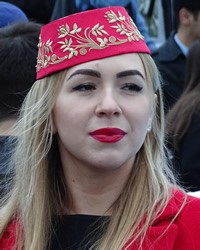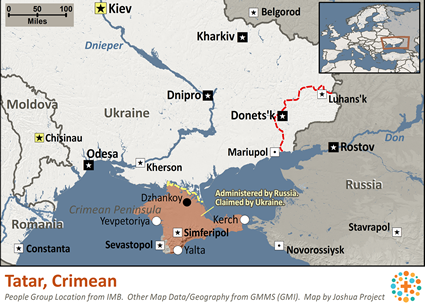The Crimean Tatars are a very diverse ethnic group that formed as result of the merger of Tatarized Muslims in Crimea and are the descendants of many different ethnic groups that inhabited Crimea, many of which were originally Christians before Muslim occupation forced them to convert to Islam. While they share some cultural similarities with the Volga Tatars who are also Muslims, they are not derived from the Volga Tatars and have a separate origin. Not being recognized as a distinct ethnic group in the Soviet era and exile from their homeland is a huge source of trauma to Crimean Tatar people. Despite being recognized as an indigenous people of Crimea by Lenin, their indigenous status was stripped in 1944 and they still have not been recognized as an indigenous people of Crimea by the Russian Federation, although Ukraine did recognize their indigenous status in 2014.
The Crimean Tatar people consist of four subethnic groups: The Nogays who historically inhabited the north of Crimea, the Mountain Tats who historically inhabited the central highlands of Crimea, the coastal Tats who inhabited the southshore of Crimea, and the Dajfa - Tatarized Roma who adopted Islam and voluntarily assimilated into the Crimean Tatar people. The Nogay are descendants of Nogay invaders who conquered Crimea in the 14th century. Christians from many different ethnic backgrounds in Crimea such as Greeks, Italians, Goths, and Armenians were called “Tats” by the Nogays and were forced to convert to Islam: however, they were still treated as second-class citizens of the Crimean Khanate and the word “Tat” originally had a derogatory connotation. Many Coastal Tats retained some Christian traditions until their forced exile to Uzbekistan. During the Holocaust many Dajfa Crimean Tatars were targeted for extermination by the Nazis, but the Crimean Tatar community was very protective of them as fellow Muslims and helped many of them pass as non-Roma.
In 1944 the Crimean Tatars were universally accused collaborating with the Nazis and deported to mostly Central Asia, except for Crimean Tatar women married to non-Crimean Tatar men - including veterans of the Red Army. Many died in transit to Central Asia and in the first years of exile, where they lived under the “special settler” regime that forbid them from leaving the village they were assigned to. Many of their traditions were lost in exile. While many other exiled ethnic groups accused of treason were rehabilitated in 1956 by Khrushchev and allowed to return to their homelands, the Crimean Tatars were not granted such right, and the government suggested they relocate to the Tatar ASSR, based on the misconception that Crimean Tatars were part of the unrelated Volga Tatar people. Despite frequently trying to explain to the government that they were a separate ethnic group, the government refused to admit that Crimean Tatars were a distinct ethnic group and cracked down on use of the term Crimean Tatar. Even though both Uzbeks and Crimean Tatars are Muslims, relations between the two groups are not always good. Some Uzbeks view Crimean Tatars as honorary Russians due to the extent of Russification of Crimean Tatars and their relatively secular culture compared to Uzbeks.
In 1989 after Uzbek mobs committed pogroms against ethnic minorities in the Uzbek SSR, the government finally allowed Crimean Tatars to return to Crimea, and today they make up approximately 12% of the population of Crimea, which is dominated by ethnic Russians who are generally hostile towards Crimean Tatars.
Family ties are very important to the Crimean Tatars. The size of the immediate family ranges from four to five members. However, two or three generations will often live in the same house. Intermarriage is a controversial subject, but many Crimean Tatar women marry non-Muslim Russian and Ukrainian men despite the practice widely being considered forbidden in Islam. Despite the popular misconception, Crimean Tatars are not strictly patrilineal, even though many Muslim people-groups are strictly patrilineal. Many people with a Crimean Tatar father and non-Crimean Tatar mother do not consider themself Crimean Tatars, and many people with a non-Crimean Tatar father and a Crimean mother consider themselves to be Crimean Tatar, most notably the Crimean Tatar national hero Amet-khan Sultan.
Crimean Tatars have been Sunni Muslims for centuries, but most of them have ancestors that were Christians forced to convert to Islam. Most Crimean Tatar Muslims are Hanafi, but many incorporate elements from other Islamic beliefs; for example, many Crimean Tatars observe Mourning of Muharram, a Shia tradition, instead of the standard Sunni tradition of celebrating Muharram. Overall, they are one of the most secular Muslim people-groups. Russians in the Soviet era often denied the fact that Crimean Tatars had Christian ancestry and Soviet propaganda often depicted them as Mongol invaders with no historic roots in Crimea, but Imperial Russian anthropologists widely acknowledged the diverse origins of Crimean Tatars and noticed that some inhabiting the southern coast still observed some Christian holidays and baked bread with the shape of a cross. Some Crimean Tatars who have developed an interest in Christianity and their Christian past have been rejected by the Russian Orthodox Church and told that they have no place in Christianity, leading to a misconception among some Crimean Tatars that Christianity is an ethnoreligion that does not want or even allow Crimean Tatars to convert.
Despite being Muslims, they tend to have little interest in violent jihad and tend to commit self-harm more often than external violence. One of the most revered members of their community, with a status somewhat akin to a Catholic Patron Saint, was Musa Mamut - who committed self-immolation in protest to being forced to leave Crimea in 1978, although cremation is widely considered to be haram, forbidden. This is in sharp contrast to other Muslim communities in Russia that prefer the use of suicide bombing. However, there is an increasing polarization of Crimean Tatar religious beliefs, with some developing extremist beliefs and others who stop believing in Islam altogether. As Muslims, they believe that the suffering they experience in their life is part of a test. Despite being Muslims, they tend to be very forgiving, often more so than their Russian Christian neighbors in Crimea, however, they are often jealous of other ethnic groups in Russia who are more respected by Russian society, especially the Volga Tatars.
Economically, Crimean Tatars tend to be poorer than their Slavic counterparts in Crimea and tend to work in blue-collar jobs, but their economic situation has been improving over time. Some schools are providing instruction to children in the Crimean Tatar language, but most Crimean Tatars are not fluent in it. However, they still face discrimination in Crimea, leading many to try to assimilate further or even conceal their Crimean Tatar background. Some have developed an interest in their Christian ancestry, but many have a negative view of Christianity due to poor relations with Russian Christians. However, relations with other Christian communities such as Armenians tend to be much better. Nevertheless, they tend to be skeptical of outsiders due to a long history of being abused by non-Crimean Tatars. Many Crimean Tatars suffer from depression as result of the stigma of being Crimean Tatar and feelings of hopelessness about their political situation. Anecdotal evidence suggest that their rates of suicide and drug abuse is abnormally high for a Muslim-majority ethnic group. Most Crimean Tatars have never been told “Jesus loves you” by a Christian and will be shocked (but not offended) to hear it, having grown used to being the subject of hate from Russian Christians. Those who convert to Christianity may be the subject of harassment from Russian Orthodox Christians who think that Crimean Tatars have no place in Christianity or do not deserve salvation.
Pray for the Crimean Tatars to receive justice and mercy so that their needs will be met.
Pray for the Lord to reveal himself to Crimean Tatars who are willing to seek and find the only savior.
Pray for Holy Spirit-driven workers to go to the Crimean Tatars.
Pray for a movement to Christ among the Crimean Tatars in Russia.
Scripture Prayers for the Tatar, Crimean in Russia.
| Profile Source: Joshua Project |


























